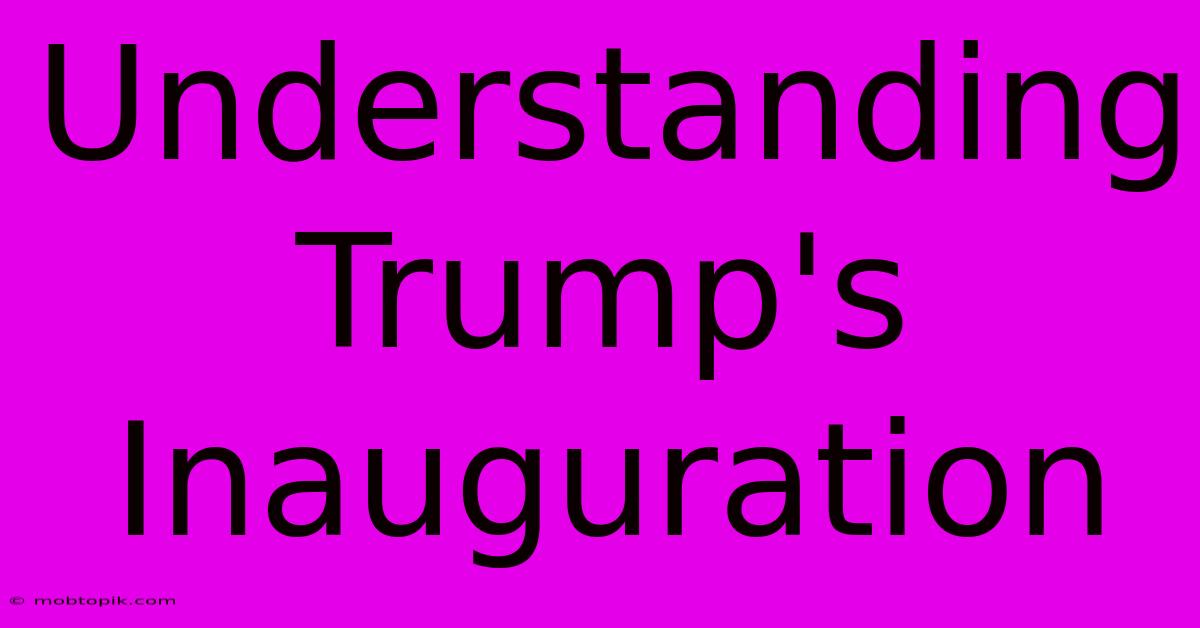Understanding Trump's Inauguration

Discover more detailed and exciting information on our website. Click the link below to start your adventure: Visit Best Website mobtopik.com. Don't miss out!
Table of Contents
Understanding Trump's Inauguration: A Deep Dive into the Events and Aftermath
Donald Trump's inauguration as the 45th President of the United States on January 20, 2017, was a highly significant event, marked by both unprecedented levels of anticipation and controversy. Understanding its nuances requires examining the pre-inauguration climate, the ceremony itself, the immediate reactions, and its lasting impact on American politics. This article delves into these aspects, offering a comprehensive analysis of this pivotal moment in recent history.
The Pre-Inauguration Atmosphere: A Nation Divided
The period leading up to Trump's inauguration was characterized by deep political polarization. Trump's victory in the 2016 presidential election had been fiercely contested, with accusations of Russian interference and widespread protests across the country. His unconventional campaign style, populist rhetoric, and controversial statements had alienated many Americans, while simultaneously galvanizing a strong base of support. This division manifested itself in several ways:
Record-Low Approval Ratings: Trump's approval ratings were exceptionally low before he even took office, a stark contrast to the typically higher numbers enjoyed by incoming presidents. This reflected the deep concerns many Americans held about his policies and character.
The Women's March: The day after the inauguration, millions participated in the Women's March on Washington and other sister marches worldwide, demonstrating against Trump's policies, particularly those perceived as harmful to women and minority groups. This massive display of dissent highlighted the significant opposition to his presidency from the outset.
Increased Security Concerns: The unprecedented level of political division led to heightened security concerns surrounding the inauguration. The Secret Service faced a significant challenge in protecting the incoming president amidst a climate of intense social and political unrest.
The Inauguration Ceremony: A Symbolic Clash
The inauguration ceremony itself was a blend of traditional pomp and circumstance and stark departures from established norms. While adhering to the basic framework of past inaugurations, several aspects stood out:
The Crowd Size Controversy: Trump's team made controversial claims about the size of the inauguration crowd, attempting to downplay photographic evidence suggesting lower attendance than previous inaugurations. This early emphasis on alternative facts set the tone for his administration's relationship with the truth and the media.
The Speeches: Trump's inaugural address reflected his campaign rhetoric, emphasizing themes of American nationalism, economic protectionism, and a rejection of globalism. His populist message resonated strongly with his supporters, while further alienating critics who viewed his vision as divisive and dangerous.
The Attendees: The guest list, notably absent many traditional political figures, signaled a deliberate attempt to break from the established political order. This choice further emphasized the president's desire to establish a distinct political identity.
Immediate Reactions and the Aftermath
The immediate aftermath of the inauguration saw a flurry of activity, both domestically and internationally:
Executive Orders: Trump quickly began enacting his campaign promises through a series of executive orders, focusing on issues such as immigration, environmental regulations, and healthcare. These actions sparked immediate legal challenges and further intensified political polarization.
International Relations: Trump's inaugural address and subsequent actions signaled a shift in American foreign policy, emphasizing "America First" principles and challenging existing alliances. This approach led to considerable uncertainty and apprehension among America's allies.
Media Scrutiny: The Trump administration faced unprecedented levels of media scrutiny from the outset. The president's frequent use of social media, his confrontational approach to the press, and the numerous controversies surrounding his administration fueled a constant cycle of news coverage.
Long-Term Impacts: A Legacy of Division and Change
The long-term impact of Trump's inauguration continues to unfold. However, some key consequences are already evident:
Increased Political Polarization: The inauguration served as a catalyst for even greater political polarization within the United States. The deep divisions that existed before the election were significantly exacerbated by Trump's presidency, resulting in increased partisan conflict and gridlock.
Shift in the Political Landscape: Trump's presidency fundamentally altered the political landscape, ushering in a new era of populist politics and challenging traditional political norms. His impact is felt across various aspects of American life, from the political discourse to social and cultural attitudes.
Challenges to Democratic Norms: Concerns about attacks on democratic institutions and norms emerged during and after Trump's presidency. These concerns included accusations of undermining the independence of the judiciary, attempts to influence election outcomes, and tolerance of misinformation and disinformation.
Conclusion: A Turning Point in American History
Trump's inauguration was a watershed moment in American history, marking a significant departure from previous presidencies. The pre-inauguration climate of intense division, the ceremony itself, and the subsequent events all contributed to a period of profound political and social upheaval. Understanding this pivotal event requires a nuanced analysis of its various facets, from the deep political polarization that preceded it to its long-term consequences for American democracy and its role in the world. The legacy of this inauguration continues to be debated and analyzed, shaping ongoing discussions about the future of American politics. Its impact on the nation's political culture and international relations will undoubtedly be studied and discussed for decades to come.

Thank you for visiting our website wich cover about Understanding Trump's Inauguration. We hope the information provided has been useful to you. Feel free to contact us if you have any questions or need further assistance. See you next time and dont miss to bookmark.
Also read the following articles
| Article Title | Date |
|---|---|
| Viking Sports January 6th News | Jan 07, 2025 |
| President Trump Inauguration Day | Jan 07, 2025 |
| 2025 Inauguration A Trump Mlk Day Conflict | Jan 07, 2025 |
| Trump Era Unusual Occurrences | Jan 07, 2025 |
| Trumps Inauguration A Timeline | Jan 07, 2025 |
